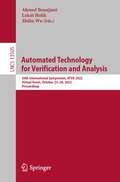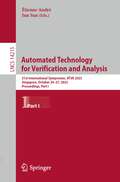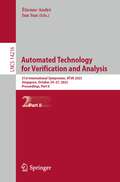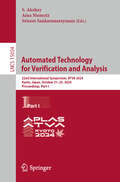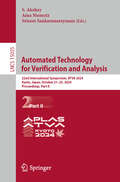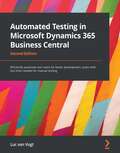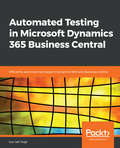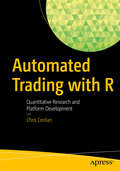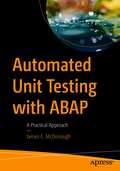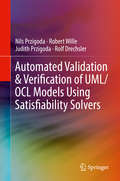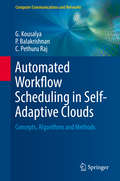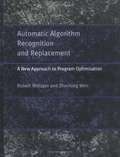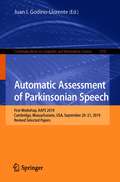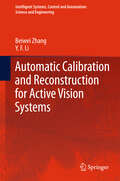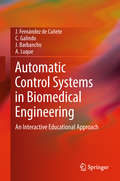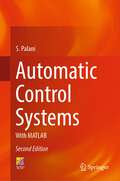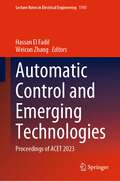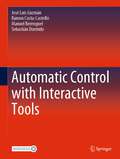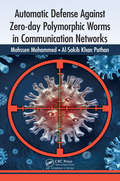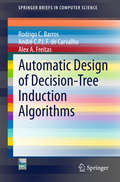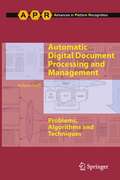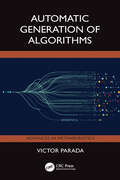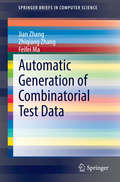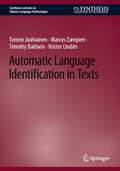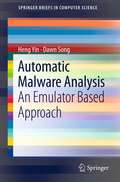- Table View
- List View
Automated Technology for Verification and Analysis: 20th International Symposium, ATVA 2022, Virtual Event, October 25–28, 2022, Proceedings (Lecture Notes in Computer Science #13505)
by Ahmed Bouajjani Lukáš Holík Zhilin WuThis book constitutes the refereed proceedings of the 20th International Symposium on Automated Technology for Verification and Analysis, ATVA 2022, held in Beiging, China in October 2022. The symposium is dedicated to promoting research in theoretical and practical aspects of automated analysis, verification and synthesis by providing an international venue for the researchers to present new results. The 21 regular papers presented together with 5 tool papers and 1 invited paper were carefully reviewed and selected from 81 submissions.The papers are divided into the following topical sub-headings: reinforcement learning; program analysis and verification; smt and verification; automata and applications; active learning; probabilistic and stochastic systems; synthesis and repair; and verification of neural networks.
Automated Technology for Verification and Analysis: 21st International Symposium, ATVA 2023, Singapore, October 24–27, 2023, Proceedings, Part I (Lecture Notes in Computer Science #14215)
by Jun Sun Étienne AndréThis book constitutes the refereed proceedings of the 21st International Symposium on Automated Technology for Verification and Analysis, ATVA 2023, held in Singapore, in October 2023. The symposium intends to promote research in theoretical and practical aspects of automated analysis, verification and synthesis by providing a forum for interaction between regional and international research communities and industry in related areas. The 30 regular papers presented together with 7 tool papers were carefully reviewed and selected from 150 submissions.The papers are divided into the following topical sub-headings: Temporal logics, Data structures and heuristics, Verification of programs and hardware.
Automated Technology for Verification and Analysis: 21st International Symposium, ATVA 2023, Singapore, October 24–27, 2023, Proceedings, Part II (Lecture Notes in Computer Science #14216)
by Jun Sun Étienne AndréThis book constitutes the refereed proceedings of the 21st International Symposium on Automated Technology for Verification and Analysis, ATVA 2023, held in Singapore, in October 2023. The symposium intends to promote research in theoretical and practical aspects of automated analysis, verification and synthesis by providing a forum for interaction between regional and international research communities and industry in related areas. The 30 regular papers presented together with 7 tool papers were carefully reviewed and selected from 150 submissions.The papers are divided into the following topical sub-headings: Temporal logics, Data structures and heuristics, Verification of programs and hardware.
Automated Technology for Verification and Analysis: 22nd International Symposium, ATVA 2024, Kyoto, Japan, October 21–25, 2024, Proceedings, Part I (Lecture Notes in Computer Science #15054)
by Sriram Sankaranarayanan S. Akshay Aina NiemetzThe two-volume set 15054-15055 constitutes the refereed proceedings of the 22nd International Symposium on Automated Technology for Verification and Analysis, ATVA 2024, held in Kyoto, Japan, from October 21 - 25, 2024. The 24 full papers presented in this volume were carefully reviewed and selected from 73 submissions. The topics presented in these volumes are organized in the following topical sections: Part I: Invited Keynote and Tutorial Papers; Automata and Games; Concurrent and Distributed Systems; Learning for Verification and Synthesis. Part II: Synthesis and Runtime Verification; Software Verification and Programming Language Semantics; Automated Reasoning and Verification.
Automated Technology for Verification and Analysis: 22nd International Symposium, ATVA 2024, Kyoto, Japan, October 21–25, 2024, Proceedings, Part II (Lecture Notes in Computer Science #15055)
by Sriram Sankaranarayanan S. Akshay Aina NiemetzThe two-volume set 15054-15055 constitutes the refereed proceedings of the 22nd International Symposium on Automated Technology for Verification and Analysis, ATVA 2024, held in Kyoto, Japan, from October 21 - 25, 2024. The 24 full papers presented in this volume were carefully reviewed and selected from 73 submissions. The topics presented in these volumes are organized in the following topical sections: Part I: Invited Keynote and Tutorial Papers; Automata and Games; Concurrent and Distributed Systems; Learning for Verification and Synthesis. Part II: Synthesis and Runtime Verification; Software Verification and Programming Language Semantics; Automated Reasoning and Verification.
Automated Testing in Microsoft Dynamics 365 Business Central: Efficiently automate test cases for faster development cycles with less time needed for manual testing, 2nd Edition
by Luc van VugtLearn how to write automated tests for Dynamics 365 Business Central and discover how you can implement them in your daily workKey FeaturesLeverage automated testing to advance over traditional manual testing methodsWrite, design, and implement automated testsExplore various testing frameworks and tools compatible with Microsoft Dynamics 365 Business CentralBook DescriptionDynamics 365 Business Central is a cloud-based SaaS ERP proposition from Microsoft. With development practices becoming more formal, implementing changes or new features is not as simple as it used to be back when Dynamics 365 Business Central was called Navigator, Navision Financials, or Microsoft Business Solutions-Navision, and the call for test automation is increasing.This book will show you how to leverage the testing tools available in Dynamics 365 Business Central to perform automated testing. Starting with a quick introduction to automated testing and test-driven development (TDD), you'll get an overview of test automation in Dynamics 365 Business Central. You'll then learn how to design and build automated tests and explore methods to progress from requirements to application and testing code. Next, you'll find out how you can incorporate your own as well as Microsoft tests into your development practice. With the addition of three new chapters, this second edition covers in detail how to construct complex scenarios, write testable code, and test processes with incoming and outgoing calls.By the end of this book, you'll be able to write your own automated tests for Microsoft Business Central.What you will learnUnderstand the why and when of automated testingDiscover how test-driven development can help to improve automated testingExplore the six pillars of the Testability Framework of Business CentralDesign and write automated tests for Business CentralMake use of standard automated tests and their helper librariesUnderstand the challenges in testing features that interact with the external worldIntegrate automated tests into your development practiceWho this book is forThis book is for consultants, testers, developers, and development managers working with Microsoft Dynamics 365 Business Central. Functional as well as technical development teams will find this book on automated testing techniques useful.
Automated Testing in Microsoft Dynamics 365 Business Central: Efficiently automate test cases in Dynamics NAV and Business Central
by Luc van VugtLearn how to write automated tests for Dynamics 365 Business Central and see how to implement it in your daily workKey FeaturesLeverage automated testing to advance over traditional manual testing methodsWrite, design, and implement automated testsExplore various testing frameworks and tools compatible with Microsoft Dynamics 365 Business CentralBook DescriptionDynamics 365 Business Central is the new cloud-based SaaS ERP proposition from Microsoft. It’s not as simple as it used to be way back when it was called Navigator, Navision Financials, or Microsoft Business Solutions-Navision. Our development practices are becoming more formal, and with this, the call for test automation is pressing on us.This book will teach you to leverage testing tools available with Dynamics 365 Business Central to perform automated testing. We’ll begin with a quick introduction to automated testing, followed by an overview of test automation in Dynamics 365 Business Central. Then you’ll learn to design and build automated tests and we’ll go through some efficient methods to get from requirements to application and testing code. Lastly, you’ll learn to incorporate your own and Microsoft tests into your daily development practice.By the end of the book, you’ll be able to write your own automated tests for Dynamics 365 Business Central.What you will learnUnderstand what automated tests are, and when and why to use themExplore the five pillars of the Testability Framework of Business CentralDesign and write automated tests for Business CentralMake use of standard automated tests and their helper librariesIntegrate automated tests into your development practiceWho this book is forThis book is for consultants, testers, developers, and development managers working with Microsoft Dynamics NAV and Business Central. Being a book on automated testing techniques, it also caters to both functional and technical development teams.
Automated Trading with R
by Chris ConlanLearn to trade algorithmically with your existing brokerage, from data management, to strategy optimization, to order execution, using free and publicly available data. Connect to your brokerage’s API, and the source code is plug-and-play.Automated Trading with R explains automated trading, starting with its mathematics and moving to its computation and execution. You will gain a unique insight into the mechanics and computational considerations taken in building a back-tester, strategy optimizer, and fully functional trading platform.The platform built in this book can serve as a complete replacement for commercially available platforms used by retail traders and small funds. Software components are strictly decoupled and easily scalable, providing opportunity to substitute any data source, trading algorithm, or brokerage. This book will:Provide a flexible alternative to common strategy automation frameworks, like Tradestation, Metatrader, and CQG, to small funds and retail tradersOffer an understanding of the internal mechanisms of an automated trading systemStandardize discussion and notation of real-world strategy optimization problemsWhat You Will LearnUnderstand machine-learning criteria for statistical validity in the context of time-seriesOptimize strategies, generate real-time trading decisions, and minimize computation time while programming an automated strategy in R and using its package libraryBest simulate strategy performance in its specific use case to derive accurate performance estimatesUnderstand critical real-world variables pertaining to portfolio management and performance assessment, including latency, drawdowns, varying trade size, portfolio growth, and penalization of unused capitalWho This Book Is ForTraders/practitioners at the retail or small fund level with at least an undergraduate background in finance or computer science; graduate level finance or data science students
Automated Unit Testing with ABAP: A Practical Approach
by James E. McDonoughWrite automated unit tests for the ABAP language. This book teaches programmers using simple examples and metaphors and explains the underlying concepts of writing effective automated unit tests. Many, if not most, ABAP programmers learned their programming and testing skills before the ABAP development environment provided an automated unit testing facility. Automated Unit Testing with ABAP: A Practical Approach offers hope and salvation to ABAP programmers who continue to toil with antiquated manual unit testing processes, taking them by the hand and lifting them out of that dungeon of despair with a modern and proven alternative. It begins by explaining how the xUnit family of automated testing frameworks provides a quick and effective means of insuring high-quality software. It then focuses on the ABAP Unit Testing Facility, the xUnit framework applicable specifically to the ABAP language, showing how it can be used to bring ABAP applications under automated testing control, from old legacy applications to those newly written.Whereas xUnit testing has been widely accepted with developers writing in many other programming languages, it is an unfortunate fact in the ABAP community that many programmers still are unfamiliar with xUnit concepts and do not know how to begin implementing automated unit testing into their development process. This book demonstrates how to refactor programs so they become designed for testability, showing how to use process encapsulation and test isolation to facilitate automated testing, including a thorough explanation of test-driven development and the use of test doubles. The book: Shows how to write automated unit tests for ABAPInstills ABAP programmers with the confidence to refactor poorly written codeExplains how an automated testing harness facilitates rapid software developmentTeaches how to utilize test-driven development (TDD) with ABAPOffers advice and tips on the best ways to write automated unit tests What You Will Learn Become familiar with the xUnit approach to testingKnow the ABAP statements that interfere with running automated unit tests and how to accommodate themUnderstand what it means to isolate code for testing and how this is achievedGain the confidence to refactor poorly written codeMake ABAP programs designed for testabilityReap the benefits of spending less time manually unit testing ABAP programsUse test-driven development (TDD) with ABAP programmingUse configurable test doubles in ABAP Who This Book Is ForABAP programmers who remain unfamiliar with the automated unit testing facility and those who already use it but want to improve their skill writing and using automated tests. The book addresses the reluctance and trepidation felt by procedural ABAP programmers who need to know some object-oriented concepts to use this facility, expands their horizons, and helps them step through the doorway leading to a different approach to program design.
Automated Validation & Verification of UML/OCL Models Using Satisfiability Solvers
by Robert Wille Rolf Drechsler Nils Przigoda Judith PrzigodaThis book provides a comprehensive discussion of UML/OCL methods and design flow, for automatic validation and verification of hardware and software systems. While the presented flow focuses on using satisfiability solvers, the authors also describe how these methods can be used for any other automatic reasoning engine. Additionally, the design flow described is applied to a broad variety of validation and verification tasks. The authors also cover briefly how non-functional properties such as timing constraints can be handled with the described flow.
Automated Workflow Scheduling in Self-Adaptive Clouds: Concepts, Algorithms and Methods (Computer Communications and Networks)
by G. Kousalya P. Balakrishnan C. Pethuru RajThis timely text/reference presents a comprehensive review of the workflow scheduling algorithms and approaches that are rapidly becoming essential for a range of software applications, due to their ability to efficiently leverage diverse and distributed cloud resources. Particular emphasis is placed on how workflow-based automation in software-defined cloud centers and hybrid IT systems can significantly enhance resource utilization and optimize energy efficiency. Topics and features: describes dynamic workflow and task scheduling techniques that work across multiple (on-premise and off-premise) clouds; presents simulation-based case studies, and details of real-time test bed-based implementations; offers analyses and comparisons of a broad selection of static and dynamic workflow algorithms; examines the considerations for the main parameters in projects limited by budget and time constraints; covers workflow management systems, workflow modeling and simulation techniques, and machine learning approaches for predictive workflow analytics. This must-read work provides invaluable practical insights from three subject matter experts in the cloud paradigm, which will empower IT practitioners and industry professionals in their daily assignments. Researchers and students interested in next-generation software-defined cloud environments will also greatly benefit from the material in the book.
Automatic Algorithm Recognition and Replacement: A New Approach to Program Optimization
by Robert Metzger Zhaofang WenParallel computation will become the norm in the coming decades. Unfortunately, advances in parallel hardware have far outpaced parallel applications of software. There are currently two approaches to applying parallelism to applications.
Automatic Assessment of Parkinsonian Speech: First Workshop, AAPS 2019, Cambridge, Massachussets, USA, September 20–21, 2019, Revised Selected Papers (Communications in Computer and Information Science #1295)
by Juan I. Godino-LlorenteThis book constitutes the revised and extended papers of the First Automatic Assessment of Parkinsonian Speech Workshop, AAPS 2019, held in Cambridge, Massachusetts, USA, in September 2019. The 6 full papers were thoroughly reviewed and selected from 15 submissions. They present recent research on the automatic assessment of parkinsonian speech from the point of view of such disciplines as machine learning, speech technology, phonetics, neurology, and speech therapy
Automatic Calibration and Reconstruction for Active Vision Systems (Intelligent Systems, Control and Automation: Science and Engineering #57)
by Y. F. Li Beiwei ZhangIn this book, the design of two new planar patterns for camera calibration of intrinsic parameters is addressed and a line-based method for distortion correction is suggested. The dynamic calibration of structured light systems, which consist of a camera and a projector is also treated. Also, the 3D Euclidean reconstruction by using the image-to-world transformation is investigated. Lastly, linear calibration algorithms for the catadioptric camera are considered, and the homographic matrix and fundamental matrix are extensively studied. In these methods, analytic solutions are provided for the computational efficiency and redundancy in the data can be easily incorporated to improve reliability of the estimations. This volume will therefore prove valuable and practical tool for researchers and practioners working in image processing and computer vision and related subjects.
Automatic Control Systems in Biomedical Engineering: An Interactive Educational Approach
by J. Fernández de Cañete C. Galindo J. Barbancho A. LuqueThis book presents the fundamental principles and challenges encountered in the control of biomedical systems, providing practical solutions and suggesting alternatives. The perspective of the text is based on the system behaviour in the time domain both linear and non-linear, continuous and discrete, helping the reader to be able to interpret the physical significance of mathematical results during control system analysis and design focusing on biomedical engineering applications. Interactive learning is promoted, endowing students with the ability to change parameters and conditions during the simulation and see the effects of these changes, by using interactive MATLAB and SIMULINK software tools, also presenting realistic problems in order to analyse, design and develop automatic control systems. The text is also complemented with MATLAB and SIMULINK exercise files solved to aid students to focus on the fundamental concepts treated throughout the book, following a new pedagogical approach distinct from the classical one whereby fundamental control concepts are introduced together with adequate software tools in order to gain insight on the biomedical engineering control problems. The book is suitable for second or third-year undergraduate students who will find the illustrative examples particularly useful to their studies of control system design and implementation. Lecturers in the control field will find the computer aided design approach as an alternative to teaching the fundamental concepts of feedback analogic and digital control.
Automatic Control Systems: With MATLAB
by S. PalaniThis book is designed to serve as a textbook for courses offered to undergraduate students enrolled in Electrical Engineering and related disciplines. The book provides a comprehensive coverage of linear system theory. In this book, the concepts around each topic are well discussed with a full-length presentation of numerical examples. Each example is unique in its way, and it is graded sequentially. This book highlights simple methods for solving problems. Even though, the subject requires a very strong mathematical foundation, wherever possible, rigorous mathematics is simplified for a quick understanding of the basic concepts. The book also includes select numerical problems to test the capability of the students. Time and frequency domain approaches for the analysis and design of linear automatic control systems have been explained using state-space and transfer function models of physical systems. All the chapters include a short theoretical summary of the topic followed by exercises on solving complex problems using MATLAB commands. In addition, each chapter offers a large number of end-of-chapter homework problems. This second edition includes a new chapter on state-space modeling and analysis. Detailed conceptual coverage and pedagogical tools make this an ideal textbook for students and researchers enrolled in electrical engineering and related programs.
Automatic Control and Emerging Technologies: Proceedings of ACET 2023 (Lecture Notes in Electrical Engineering #1141)
by Weicun Zhang Hassan El FadilThis book contains the original, peer-reviewed research papers from the International Symposium on Automatic Control and Emerging Technologies, held in Kenitra, Morrocco, on July 11-13, 2023. The topics covered include but are not limited to: System Identification, Linear/Nonlinear Control Systems, Data-driven Modelling and Control, Process Modelling and Process Control, Fault Diagnosis and Reliable Control, Intelligent Systems, and Machine Learning and Artificial Intelligence.The papers showcased here share the latest findings on topics with potential for academic research and industrial applications, making the book a valuable resource for researchers, engineers, and university students alike.
Automatic Control with Interactive Tools
by Manuel Berenguel José Luis Guzmán Ramon Costa-Castelló Sebastián DormidoAutomatic Control with Interactive Tools is a textbook for undergraduate study of automatic control. Providing a clear course structure, and covering concepts taught in engineering degrees, this book is an ideal companion to those studying or teaching automatic control. The authors have used this text successfully to teach their students.By providing unique interactive tools, which have been designed to illustrate the most important automatic control concepts, Automatic Control with Interactive Tools helps students overcome the potential barriers presented by the significant mathematical content of automatic control courses. Even when they have previously had only the benefit of an introductory control course, the software tools presented will help readers to get to grips with the use of such techniques as differential equations, linear algebra, and differential geometry. This textbook covers the breadth of automatic control topics, including time responses of dynamic systems, the Nyquist criterion and PID control. It switches smoothly between analytical and practical approaches. Automatic Control with Interactive Tools offers a clear introduction to automatic control, ideal for undergraduate students, instructors and anyone wishing to familiarize themselves with the fundamentals of the subject
Automatic Defense Against Zero-day Polymorphic Worms in Communication Networks
by Mohssen Mohammed Al-Sakib Khan PathanAble to propagate quickly and change their payload with each infection, polymorphic worms have been able to evade even the most advanced intrusion detection systems (IDS). And, because zero-day worms require only seconds to launch flooding attacks on your servers, using traditional methods such as manually creating and storing signatures to de
Automatic Design of Decision-Tree Induction Algorithms (SpringerBriefs in Computer Science)
by Rodrigo C. Barros André C.P.L.F de Carvalho Alex A. FreitasPresents a detailed study of the major design components that constitute a top-down decision-tree induction algorithm, including aspects such as split criteria, stopping criteria, pruning and the approaches for dealing with missing values. Whereas the strategy still employed nowadays is to use a 'generic' decision-tree induction algorithm regardless of the data, the authors argue on the benefits that a bias-fitting strategy could bring to decision-tree induction, in which the ultimate goal is the automatic generation of a decision-tree induction algorithm tailored to the application domain of interest. For such, they discuss how one can effectively discover the most suitable set of components of decision-tree induction algorithms to deal with a wide variety of applications through the paradigm of evolutionary computation, following the emergence of a novel field called hyper-heuristics. "Automatic Design of Decision-Tree Induction Algorithms" would be highly useful for machine learning and evolutionary computation students and researchers alike.
Automatic Digital Document Processing and Management: Problems, Algorithms and Techniques (Advances in Computer Vision and Pattern Recognition)
by Stefano FerilliThis text reviews the issues involved in handling and processing digital documents. Examining the full range of a document's lifetime, the book covers acquisition, representation, security, pre-processing, layout analysis, understanding, analysis of single components, information extraction, filing, indexing and retrieval. Features: provides a list of acronyms and a glossary of technical terms; contains appendices covering key concepts in machine learning, and providing a case study on building an intelligent system for digital document and library management; discusses issues of security, and legal aspects of digital documents; examines core issues of document image analysis, and image processing techniques of particular relevance to digitized documents; reviews the resources available for natural language processing, in addition to techniques of linguistic analysis for content handling; investigates methods for extracting and retrieving data/information from a document.
Automatic Generation Of Algorithms (Advances in Metaheuristics)
by Victor ParadaIn the rapidly evolving domain of computational problem-solving, this book delves into the cutting-edge Automatic Generation of Algorithms (AGA) paradigm, a groundbreaking approach poised to redefine algorithm design for optimization problems. Spanning combinatorial optimization, machine learning, genetic programming, and beyond, it investigates AGA's transformative capabilities across diverse application areas. The book initiates by introducing fundamental combinatorial optimization concepts and NPhardness significance, laying the foundation for understanding AGA's necessity and potential. It then scrutinizes the pivotal Master Problem concept in AGA and the art of modeling for algorithm generation. The exploration progresses with integrating genetic programming and synergizing AGA with evolutionary computing. Subsequent chapters delve into the AGA-machine learning intersection, highlighting their shared optimization foundation while contrasting divergent objectives. The automatic generation of metaheuristics is examined, aiming to develop versatile algorithmic frameworks adaptable to various optimization problems. Furthermore, the book explores applying reinforcement learning techniques to automatic algorithm generation. Throughout, it invites readers to reimagine algorithmic design boundaries, offering insights into AGA's conceptual underpinnings, practical applications, and future directions, serving as an invitation for researchers, practitioners, and enthusiasts in computer science, operations research, artificial intelligence, and beyond to embark on a journey toward computational excellence where algorithms are born, evolved, and adapted to meet ever-changing real-world problem landscapes.
Automatic Generation of Combinatorial Test Data (SpringerBriefs in Computer Science)
by Jian Zhang Zhiqiang Zhang Feifei MaThis book reviews the state-of-the-art in combinatorial testing, with particular emphasis on the automatic generation of test data. It describes the most commonly used approaches in this area - including algebraic construction, greedy methods, evolutionary computation, constraint solving and optimization - and explains major algorithms with examples. In addition, the book lists a number of test generation tools, as well as benchmarks and applications. Addressing a multidisciplinary topic, it will be of particular interest to researchers and professionals in the areas of software testing, combinatorics, constraint solving and evolutionary computation.
Automatic Language Identification in Texts (Synthesis Lectures on Human Language Technologies)
by Krister Lindén Marcos Zampieri Tommi Jauhiainen Timothy BaldwinThis book provides readers with a brief account of the history of Language Identification (LI) research and a survey of the features and methods most used in LI literature. LI is the problem of determining the language in which a document is written and is a crucial part of many text processing pipelines. The authors use a unified notation to clarify the relationships between common LI methods. The book introduces LI performance evaluation methods and takes a detailed look at LI-related shared tasks. The authors identify open issues and discuss the applications of LI and related tasks and proposes future directions for research in LI.
Automatic Malware Analysis: An Emulator Based Approach (SpringerBriefs in Computer Science)
by Heng Yin Dawn SongMalicious software (i.e., malware) has become a severe threat to interconnected computer systems for decades and has caused billions of dollars damages each year. A large volume of new malware samples are discovered daily. Even worse, malware is rapidly evolving becoming more sophisticated and evasive to strike against current malware analysis and defense systems. Automatic Malware Analysis presents a virtualized malware analysis framework that addresses common challenges in malware analysis. In regards to this new analysis framework, a series of analysis techniques for automatic malware analysis is developed. These techniques capture intrinsic characteristics of malware, and are well suited for dealing with new malware samples and attack mechanisms.
